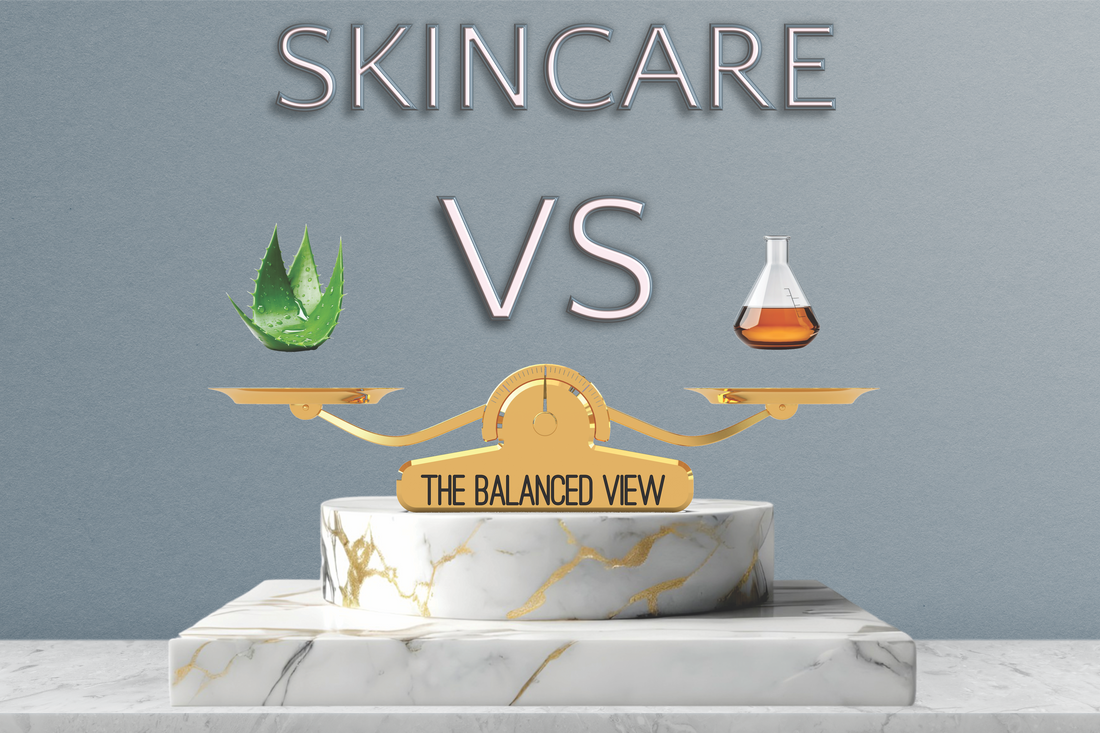
Natural vs Synthetic skincare ingredients
Please, bear with me on this one. This can be a complex subject to try and cover in one blog, but I promise if you make it to the end, you will have some clarity. Please feel free to carry on the conversation in the comments below.
Natural this, synthetic that...
Think of the word "Natural" for a second. Now think of the word "Synthetic".
Many of you will experience contrasting feelings as though these words mean opposite things or associate one with good and the other with bad.
Take a deep breath...Clear your mind of assumptions and biases and turn on your analytical self for the remainder of this blog where I will try to peel off the layers of marketing hype and common misconception surrounding these 2 words.
But first we need to define some terms:
The word “natural” is not a regulated term and can have different definitions to different brands and individuals so the best I can do for this article is to establish one for our purposes. To make things a little more precise, I will call them natural chemicals because of course, EVERYTHING IS A CHEMICAL!
Natural Chemicals
Natural chemicals are compounds that are created in nature without human intervention. They can be isolated from their natural sources through physical methods like extraction or distillation but are not modified chemically in a way that changes their basic molecular structure.
Synthetic Chemicals
Synthetic chemicals are entirely man-made and are created through chemical synthesis, typically in a laboratory or industrial setting.
Biosynthetic Chemicals
Biosynthetic chemicals are compounds that are produced by living organisms as a result of human intervention using biotechnological methods. The process involves harnessing the natural biochemical processes of microbes, plants, or animal cells to produce specific substances. Many people put biochemically derived ingredients in the "everything-else-besides-natural" category, but these substances deserve their own classification for 2 main reasons. I will get into those in a sec.
SAY IT WITH ME:
EVERYTHING IS A CHEMICAL
Good. Now that we have that established, let’s move on.
For this project, I spent a month researching over 200 chemicals, their sources, and their safety profiles. What I discovered was evidence to support what I already knew.
- Natural ingredients are not always better
- Lab synthesized ingredients are not always worse.
- Bio-synthetically engineered ingredients are generally safer and more effective.
Organizing ingredients
One of the best ways to organize the ingredients in a lab is to color code them based on their nature and risk level. Meaning, what potential harm can they cause and in what way. This color-coding system helps to ensure that chemists are always aware of the nature of the chemical that they are working with, and this sets a standard for how it is used in a formula. For the purposes of this piece, I have categorized common skincare ingredients into 5 groups.
Green Zone: The safest skincare ingredients.

Orange Zone: Potential Irritants

Red Zone: Allergenic Compounds

Purple Zone: Endocrine Disrupting/Modifying Compounds (These need their own blog... So here it is!)

Black Zone: Formaldehyde releasing preservatives

Are you surprised to learn that botanicals and essential oils dominate the allergens category? It makes sense when you remember that plants do create these compounds to defend themselves after all. Learn more about fragrances here. What about the fact that EDC's can be found in nature? Yep. Even formaldehyde is naturally occurring in fruits like bananas and pears for example. Just keep your mantra that you learned from "What skincare ingredients should you avoid" going.
How Much? How Often? How Long?
Moving on...
What observations did you make after looking at the ingredient classes above?
Surprised to see that none of the ingredients from the biosynthesized column made it to any other zones besides green? Biochemical engineers are constantly searching for ways to create ingredients that carry less risk and are more effective. Biochemistry is your skin-friend my friend!
HOWEVER,
Just like anything, biosynthetic ingredients can have a downside. In some cases, the creation of these ingredients can involve processes that might not be as environmentally friendly as some of their synthetic or natural chemical counterparts.
Does this mean that since botanicals and essential oils are classified as potential irritants and/or allergens that they should not have a place in our routines?
Absolutely not! but think of them as medicine. They are often imbued with properties that make them especially useful as medicinal remedies, but any medicine can become a poison when too much is taken right?
HOW MUCH, HOW LONG, HOW OFTEN...
What about problematic preservatives? Why are they still using them?
They continue to use some of these compounds because they are choosing the lesser of 2 evils.
Until less toxic preservatives are discovered that can perform as well as some of these more problematic synthetic ones, chemists have to make a risk assessment when formulating solvent based and non-isolated cosmetics. (Meaning that it is a liquid of any sort and is accessible to being touched) Either include a broad-spectrum preservative in a formula or run the risk of having microbial contamination and/or efficacy degradation.
There is only one way to safely omit these types of chemicals from a skincare formula without the risk of it losing its efficacy, or worse yet, becoming contaminated with microbes. You have to make it anhydrous, (solvent free) and you have to isolate it from touch by encapsulating it until it is used. (which is exactly what I did)
By now you are either feeling terrified or empowered. I assure you, my intent is for the latter to be true. You are now armed with knowledge that can allow you to make educated decisions about the types of products that you choose and how you choose to use them and how long you choose to remain in contact with them. These little educated choices can make a significant difference overall.
Isn't it nice to take back your power?
HOW MUCH, HOW LONG, HOW OFTEN...
Please go and have yourself the most quality of days,
MBM
sources:
- Analysis of Prohibited and Restricted Ingredients in Cosmetics - This study by R Pratiwi et al. (2022).
- Vetter, I., et al. (2017). "Venoms-Based Drug Discovery: Proteomic and Genomic Analyses Reveal the Plateaued Efficacy of Developed Snake Venom Peptide Drugs." Pharmaceuticals, 10(4), 77.
- Marsh, N., & Williams, V. (2005). "Practical applications of snake venom toxins in haemostasias." Toxicon, 45(8), 1171-1181.
- Zhang, Y. (2016). "Applications of natural products in the field of cancer research: Focus on venom and toxins from snakes, scorpions, and spiders." Molecular & Cellular Therapies, 4, 6.
- Ferreira, S. H., et al. (1970). "Isolation of bradykinin-potentiating peptides from Bothrops jararaca venom." Biochemistry, 9(13), 2583-2593.
- Sensors & Diagnostics (RSC Publishing). 2022. Endocrine disrupting chemicals in water and recent advances on their detection using electrochemical biosensors. Endocrine disrupting chemicals in water and recent advances on their detection using electrochemical biosensors - Sensors & Diagnostics (RSC Publishing) DOI:10.1039/D2SD00156J
- Though I did not directly quote the book, "Beyond Soap" By Dr Sandy Stotnicki largely influenced the material in this blog. I highly recommend this quick read to anyone who has skin and lives in the modern world. Dr. Sandy Skotnicki: Toronto Dermatologist, Skin Allergy Expert (drsandyskotnicki.com)

